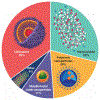Sizing up the Next Generation of Nanomedicines
- PMID: 31828540
- PMCID: PMC7274461
- DOI: 10.1007/s11095-019-2736-y
Sizing up the Next Generation of Nanomedicines
Abstract
During the past two decades the nanomedicine field has experienced significant progress. To date, over sixty nanoparticle (NP) formulations have been approved in the US and EU while many others are in clinical or preclinical development, indicating a concerted effort to translate promising bench research to commercially viable pharmaceutical products. The use of NPs as novel drug delivery systems, for example, can improve drug safety and efficacy profiles and enable access to intracellular domains of diseased cells, thus paving the way to previously intractable biological targets. However, the measurement of their physicochemical properties presents substantial challenges relative to conventional injectable formulations. In this perspective, we focus exclusively on particle size, a core property and critical quality attribute of nanomedicines. We present an overview of relevant state-of-the-art technologies for particle sizing, highlighting the main parameters that can influence the selection of techniques suitable for a specific size range or material. We consider the increasing need, and associated challenge, to measure size in physiologically relevant media. We detail the importance of standards, key to validate any measurement, and the need for suitable reference materials for processes used to characterize novel and complex NPs. This perspective highlights issues critical to achieve compliance with regulatory guidelines and to support research and manufacturing quality control.
Keywords: Physicochemical characterization; particle sizing; reference materials/standards, critical quality attributes, physiological conditions.
Conflict of interest statement
The authors confirm that this article has no conflict of interest to declare in the contents of the manuscript. The identification of any commercial product or trade name does not imply endorsement or recommendation by the National Institute of Standards and Technology, the Nanotechnology Characterization Lab, AstraZeneca or Pfizer.
Figures


Similar articles
-
Measuring particle size distribution of nanoparticle enabled medicinal products, the joint view of EUNCL and NCI-NCL. A step by step approach combining orthogonal measurements with increasing complexity.J Control Release. 2019 Apr 10;299:31-43. doi: 10.1016/j.jconrel.2019.02.030. Epub 2019 Feb 21. J Control Release. 2019. PMID: 30797868 Review.
-
Asymmetric-flow field-flow fractionation for measuring particle size, drug loading and (in)stability of nanopharmaceuticals. The joint view of European Union Nanomedicine Characterization Laboratory and National Cancer Institute - Nanotechnology Characterization Laboratory.J Chromatogr A. 2021 Jan 4;1635:461767. doi: 10.1016/j.chroma.2020.461767. Epub 2020 Nov 27. J Chromatogr A. 2021. PMID: 33310281 Review.
-
Role of Particle Size in Translational Research of Nanomedicines for Successful Drug Delivery: Discrepancies and Inadequacies.J Pharm Sci. 2023 Sep;112(9):2371-2384. doi: 10.1016/j.xphs.2023.07.002. Epub 2023 Jul 14. J Pharm Sci. 2023. PMID: 37453526 Review.
-
A review of the current scientific and regulatory status of nanomedicines and the challenges ahead.PDA J Pharm Sci Technol. 2011 Mar-Apr;65(2):177-95. PDA J Pharm Sci Technol. 2011. PMID: 21502077 Review.
-
Are existing standard methods suitable for the evaluation of nanomedicines: some case studies.Nanomedicine (Lond). 2018 Mar 1;13(5):539-554. doi: 10.2217/nnm-2017-0338. Epub 2018 Jan 30. Nanomedicine (Lond). 2018. PMID: 29381129
Cited by
-
Nanomaterials in diagnostics, imaging and delivery: Applications from COVID-19 to cancer.MRS Commun. 2022;12(6):1119-1139. doi: 10.1557/s43579-022-00257-7. Epub 2022 Oct 17. MRS Commun. 2022. PMID: 36277435 Free PMC article. Review.
-
A pragmatic regulatory approach for complex generics through the U.S. FDA 505(j) or 505(b)(2) approval pathways.Ann N Y Acad Sci. 2021 Oct;1502(1):5-13. doi: 10.1111/nyas.14662. Epub 2021 Jul 22. Ann N Y Acad Sci. 2021. PMID: 34296458 Free PMC article.
-
Preparing (Metalla)carboranes for Nanomedicine.ChemMedChem. 2021 May 18;16(10):1533-1565. doi: 10.1002/cmdc.202000983. Epub 2021 Mar 19. ChemMedChem. 2021. PMID: 33507635 Free PMC article. Review.
-
Regulatory aspects of a nanomaterial for imaging therapeutic cells.Drug Deliv Transl Res. 2023 Nov;13(11):2693-2703. doi: 10.1007/s13346-023-01359-y. Epub 2023 May 20. Drug Deliv Transl Res. 2023. PMID: 37210426 Free PMC article.
-
The Hitchhiker's Guide to Human Therapeutic Nanoparticle Development.Pharmaceutics. 2022 Jan 21;14(2):247. doi: 10.3390/pharmaceutics14020247. Pharmaceutics. 2022. PMID: 35213980 Free PMC article. Review.
References
-
- Freitas RA Jr. What is nanomedicine? Nanomedicine. 2005;1(1):2–9. - PubMed
-
- Koo OM, Rubinstein I, Onyuksel H. Role of nanotechnology in targeted drug delivery and imaging: A concise review. Nanomedicine. 2005;1(3):193–212. - PubMed
-
- Halamoda-Kenzaoui B, Calzolai L, Urban P, Zuang V, Baconnier S, Boisseau P, Bastogne T, Bazile D, Borchard G, Di FT, Borgos SE, Cederbrant K, Di FG, Dobrovolskaia MA, Gaspar R, Gracia B, Hackley VA, Leyens L, Liptrott N, Park M, Patri A, Roebben G, Roesslein M, Thurmer R, Bremer-Hoffmann S. Bridging communities in the field of nanomedicine. Regul Toxicol Pharmacol. 2019;106:187–196. - PMC - PubMed
-
- Faria M, Bjornmalm M, Thurecht KJ, Kent SJ, Parton RG, Kavallaris M, Johnston APR, Gooding JJ, Corrie SR, Boyd BJ, Thordarson P, Whittaker AK, Stevens MM, Prestidge CA, Porter CJH, Parak WJ, Davis TP, Crampin EJ, Caruso F. Minimum information reporting in bio-nano experimental literature. Nat Nanotechnol. 2018;13(9):777–785. - PMC - PubMed
-
- D’Mello SR, Cruz CN, Chen M-L, Kapoor M, Lee SL, Tyner KM. The evolving landscape of drug products containing nanomaterials in the United States. Nat Nanotechnol. 2017;12(6):523–529. - PubMed
Publication types
MeSH terms
Substances
Grants and funding
LinkOut - more resources
Full Text Sources
Miscellaneous

